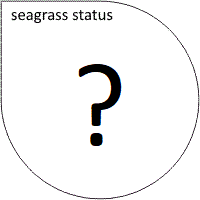Noosa
NOOSA
Eight seagrass species occur in the SEQ region (Cymodocea serrulata, Halophila decipiens, Halophila minor, Halophila ovalis, Halophila spinulosa, Halodule uninervis, Syringodium isoetifolium and Zostera muelleri subsp. capricorni (aka Zostera capricorni), with Zostera capricorni and Halophila ovalis the most common, and Halophila minor the rarest1; although H. minor taxonomy remains under review2. Seagrass communities in SEQ have been mapped several times over the past 35 years to varying degrees and accuracies.
Seagrass distribution throughout the region is most likely influenced by shelter, sediment characteristics, water turbidity and tidal exposure. The most extensive seagrass meadows in the SEQ region occur in the intertidal zone. Large seagrass meadows occur in areas of wide intertidal flats while small but dense seagrass meadows are found in association with narrow or confined channels. Seagrass do not occur on exposed oceanic shores in the region, but do occur in small intertidal areas within some rivers and creeks flowing directly into the ocean.
Between August 1987 and December 1987 a detailed survey documented the broad extent of seagrass distribution in SEQ3. Hyland et al3 identified seven species of seagrass, and estimated approximately 14,170 ha of seagrass meadows (light to dense) and 12,500 ha of sparse or patchy seagrass areas between Coolangatta and Noosa.
In August 1987, approximately 48 ha of seagrass meadows were mapped in estuaries of the Sunshine Coast3. The maps from the surveys estimate 1188 ±409 hectares of seagrass meadows between Noosa and Caloundra3, however, this figure is an over estimate, as the isolated patches within Lakes Cooroibah, Doonella and Weyba were represented in the seagrass distribution maps as large contiguous areas because mapping individual patches was not possible. Only two seagrass species have been reported from the Noosa region: Zostera muelleri subsp. capricorni and Halophila ovalis. The only mapping of seagrass in the Noosa River region since 1987, was in 2007 via remote sensing for an undergraduate project4, however no estimate of area is available.
Seagrass-Watch in the Noosa Region
To provide an early warning of change, long-term monitoring has been established on the Noosa River as part of Seagrass-Watch, Global Seagrass Observing Network (www.seagrasswatch.org).
Establishing a network of monitoring sites in the Noosa Region will provide valuable information on temporal trends on the health status of seagrass meadows in the region and will provide a tool for decision-makers in adopting protective measures. It will encourage local communities to become involved in seagrass management and protection. Working with both scientists and local stakeholders, this approach is designed to draw attention to the many local anthropogenic impacts on seagrass meadows which degrade coastal ecosystems and decrease their yield of natural resources.
Location
Goat Island
Monitoring: suspended
Principal watchers: NICA Volunteers
Location: Noosa River
Site code: NR1, NR2, NR3, NR4, NR5

Seagrass cover, species composition and canopy height
Data should be interpreted with caution as may not be fully compliant with Seagrass-Watch QAQC
Macroalgae and Epiphyte cover
Data should be interpreted with caution as may not be fully compliant with Seagrass-Watch QAQC
Location
Keyser Island
Monitoring: suspended
Principal watchers: NICA Volunteers
Location: Noosa River
Site code: KY1, KY2, KY3

Seagrass cover, species composition and canopy height
Data should be interpreted with caution as may not be fully compliant with Seagrass-Watch QAQC
Macroalgae and Epiphyte cover
Data should be interpreted with caution as may not be fully compliant with Seagrass-Watch QAQC
Location
Lake Cooroibah
Monitoring: suspended
Principal watchers: NICA Volunteers
Location: Noosa River
Site code: LC1, LC2

Seagrass cover, species composition and canopy height
Data should be interpreted with caution as may not be fully compliant with Seagrass-Watch QAQC
Macroalgae and Epiphyte cover
Data should be interpreted with caution as may not be fully compliant with Seagrass-Watch QAQC
Location
Lake Doonella
Monitoring: suspended
Principal watchers: NICA Volunteers
Location: Noosa River
Site code: LD1, LD2

Seagrass cover, species composition and canopy height
Data should be interpreted with caution as may not be fully compliant with Seagrass-Watch QAQC
Macroalgae and Epiphyte cover
Data should be interpreted with caution as may not be fully compliant with Seagrass-Watch QAQC
Location
Makepeace Island
Monitoring: suspended
Principal watchers: Seagrass-Watch HQ
Location: Noosa River
Site code: MK1, MK2, MK3

Seagrass cover, species composition and canopy height
Data should be interpreted with caution as may not be fully compliant with Seagrass-Watch QAQC
Macroalgae and Epiphyte cover
Data should be interpreted with caution as may not be fully compliant with Seagrass-Watch QAQC
Location
Weyba Creek
Monitoring: suspended
Principal watchers: NICA volunteers
Location: Noosa River
Site code: WY1, WY2, WY3, WY4, WY5, WY6
